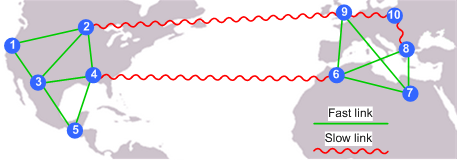If your backbone includes any slow network connections, you should set up regions. DSAs connected by slow links should be part of different regions.
For each namespace partition, each region has one hub DSA. This is the DSA that accepts multiwrite requests from DSAs in other regions.
Example: Multiwrite System with Regions to Avoid Bottlenecks
The following diagram shows a backbone with one namespace partition (Staff) across three regions:

The diagram shows the following steps:
The following steps are not shown in the diagram.
A global company has directory hosts in North America, Central America, North Africa and Europe.
This diagram shows the speed of the network connections between the sites:

Sites 1, 2, 3, 4, and 5 are linked by fast connections. Sites 6, 7, 8, and 9 are also linked by fast connections.
However, these two groups of sites are connected by slow links. Also, Site 10 is only connected to other sites by slow links.
The directory designers decide to create the following regions and sites in DXmanager:
|
Region A |
Region B |
Region C |
|
Site 1, Site 2, Site 3, Site 4, Site 5 |
Site 6, Site 7, Site 8, Site 9 |
Site 10 |
| Copyright © 2009 CA. All rights reserved. | Email CA about this topic |